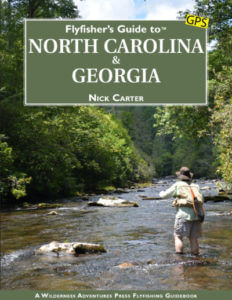(An excerpt from Flyfisher’s Guide To North Carolina & Georgia)
At its top end, high in the Shining Rock Wilderness halfway between Brevard and Waynesville, N.C., the headwaters of the East Fork of the Pigeon River are about as pretty a place as I’ve ever been. I don’t know if she takes me seriously, but I told my wife I want my ashes scattered up a particularly beautiful and hard-to-get-to tributary of the East Fork. I see it as a parting gift to my brothers, who will likely be tasked with the mission. Hopefully, they’ll take their 3-weights and put the urn in the rear pouch of a fly vest.
Tumbling from more than 5,500 feet of elevation from Black Balsam knob, Yellowstone Prong, the creek’s largest high tributary, and the East Fork itself offer close to 8 miles of wilderness trout fishing in some of the most picturesque gin-clear plunge pools and brawling pocket water anywhere.
Along with East Fork tributaries, there are untold miles of water worth exploring for native brook trout on the river’s upper end, which is accessed by relatively short hikes from several locations off of the Blue Ridge Parkway.
A word of warning, though: these flows are steep… you-might-need-a-rope steep, and it’s a long way to help if one were to get into trouble up these prongs. Even those in relatively good physical shape will find fishing these waters to be grueling.
On the lower end of its publicly accessible waters, the East Fork is flatter and much larger than it is in the brook trout waters above. The terrain is not nearly as treacherous, and with the influx of multiple tributaries, it has become a small river by the time it crosses off the eastern edge of the Shining Rock Wilderness Area. A trail gives the only viable access to several miles of river before it begins to parallel the Blue Ridge Parkway.
This stream appears to receive surprisingly light fishing pressure. There are a lot of backpackers and waterfall watchers who use the area extensively, but I guess most anglers don’t typically go this far into the woods to catch small trout.
Although the majority of the rainbows and browns you’ll catch on dries and droppers in the pocket water will range from 6 to 10 inches, there are some bruisers hanging out in the deeper holes. These deep holes are plentiful, but the bigger fish are notoriously hard to fool.
Take a few minutes to stop and watch one of the large plunge pools on the river just upstream of the trailhead. In clear water, you’ll see the smaller fish first, feeding high in the water column. Look a little longer and deeper, and fish 14 to 16 inches or longer will make themselves visible hanging near the bottom.
Flyfisher’s Guide To North Carolina & Georgia is 218 pages of extensively researched information on the area’s best trout fishing. It includes more than 40 full-color maps, photos, driving directions, GPS coordinates, tips, and tactics. It is available on wildadvpress.com, Amazon and at fly shops, and signed copies are available by contacting the author at nsc8957@gmail.com.

